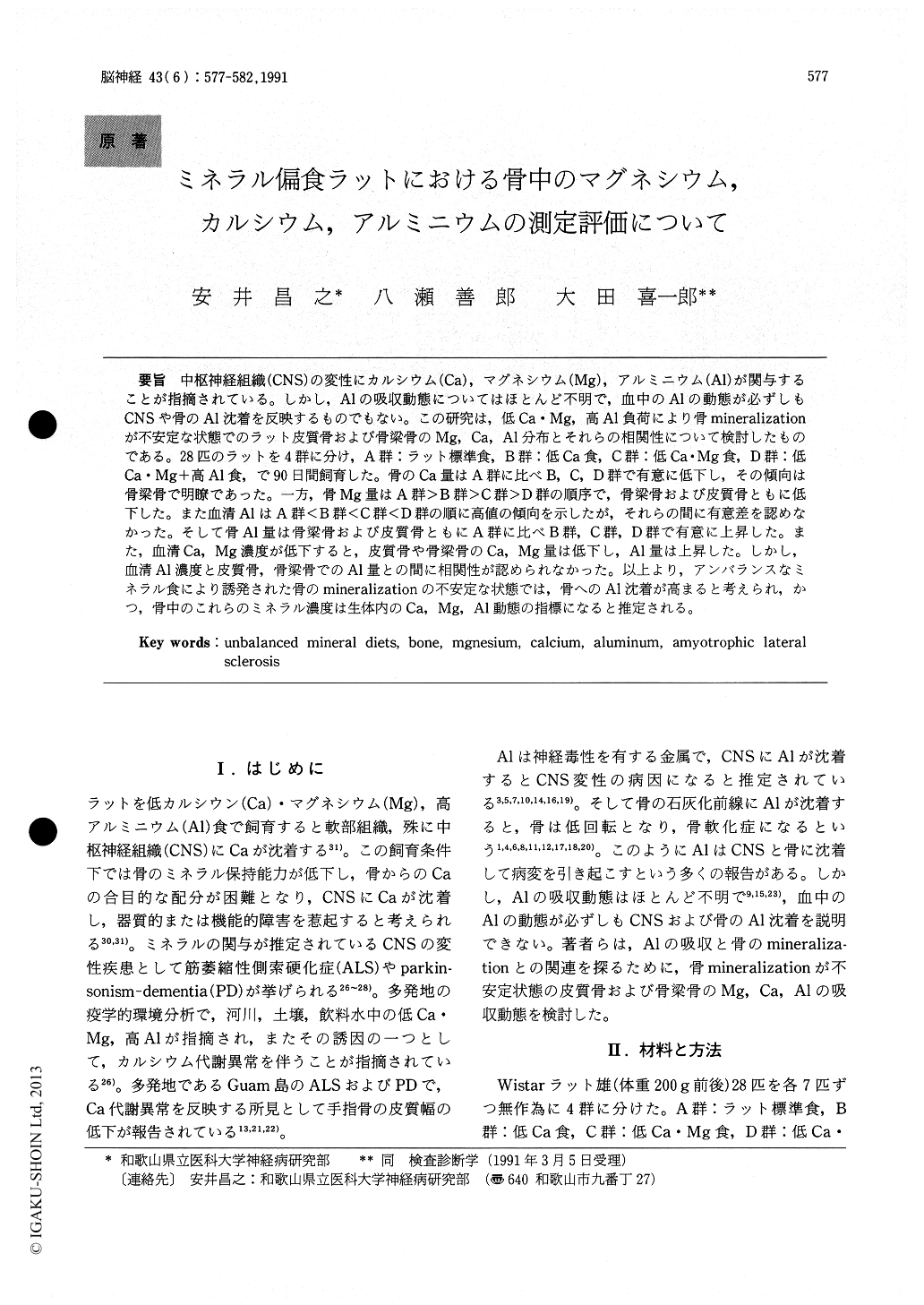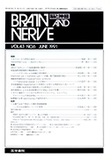Japanese
English
- 有料閲覧
- Abstract 文献概要
- 1ページ目 Look Inside
中枢神経組織(CNS)の変性にカルシウム(Ca),マグネシウム(Mg),アルミニウム(Al)が関与することが指摘されている。しかし,Alの吸収動態についてはほとんど不明で,血中のAlの動態が必ずしもCNSや骨のAl沈着を反映するものでもない。この研究は,低Ca・Mg,高Al負荷により骨mineralizationが不安定な状態でのラット皮質骨および骨梁骨のMg,Ca,Al分布とそれらの相関性について検討したものである。28匹のラットを4群に分け,A群:ラット標準食,B群:低Ca食,C群:低Ca・Mg食,D群:低Ca・Mg+高Al食,で90日間飼育した。骨のCa量はA群に比べB,C,D群で有意に低下し,その傾向は骨梁骨で明瞭であった。一方,骨Mg量はA群>B群>C群>D群の順序で,骨梁骨および皮質骨ともに低下した。また血清AlはA群<B群<C群<D群の順に高値の傾向を示したが,それらの間に有意差を認めなかった。そして骨Al量は骨梁骨および皮質骨ともにA群に比べB群,C群,D群で有意に上昇した。また,血清Ca,Mg濃度が低下すると,皮質骨や骨梁骨のCa,Mg量は低下し,Al量は上昇した。しかし,血清A1濃度と皮質骨,骨梁骨でのAl量との間に相関性が認められなかった。以上より,アンバランスなミネラル食により誘発された骨のmineralizationの不安定な状態では,骨へのAl沈着が高まると考えられ,かつ,骨中のこれらのミネラル濃度は生体内のCa,Mg,Al動態の指標になると推定される。
Current changing epidemiological pattern in the Western Pacific strongly suggests a contribution of the environmental factors to the pathogenetic proc-ess of amyotrophic lateral sclerosis (ALS). As a reflection of excess metals and a deficiency of minerals in soil and water samples in these foci, this study was designed experimentally to evaluate the concentration of calcium (Ca) , magnesium (Mg) and aluminum (Al) in the bones of rats fed unbal-anced mineral diets.
Twenty-eight male Wistar rats, weighing 200 g, were fed either a standard diet, a low Ca diet, a low Ca-Mg diet, or a low Ca-Mg diet with high Al for 90 days. The composition of the diet/100 g consists of Ca 1250 mg, Mg 300 mg, Al 10 mg, Zn 4 mg in the standard diet ; Ca 3 mg and Mg 2 mg in the low Ca -Mg diet ; and Al 194 mg in the high Al diet, Al supplied as Al lactate. Ca, Mg and Al concentra-tions were determined by using inductively coupled plasma emission spectrometry (ICP) for bone and atomic absorption spectrometry for serum.
Serum Ca levels in the groups fed unbalanced mineral diets were lower than those in the group fed standard diet. Serum Mg levels were markedly decreased in the groups fed low Ca-Mg diet and low Ca-Mg plus high Al diet, compared with those in the groups fed standard diet and low Ca diet.
Ca and Mg concentrations in lumbar and femoralbone showed higher values in a standard diet group than those in the unbalanced diet groups i. e., low Ca diet group, low Ca-Mg diet group, and low Ca-Mg plus high Al diet group.
On the other hand, there was no significant difference in serum Al levels in rats fed standard and unbalanced diets, although Al concentration in bones showed higher values in the unbalanced diets groups. The lower the levels of serum Ca and Mg, the more decreased the bone Ca and Mg concentra-tions and also the more increased the Al in bone. There was, however, no correlation between serum and bone Al levels.
A significant positive correlation between Ca andMg concentration was shown in both lumbar spine and femoral bone in rats. But a negative correlation between Al and both Ca and Mg concentration was shown in both lumbar spine and femoral bone, although a positive correlation was shown between Al concentration in both bones.
It is, therefore, postulated that the deranged mineralization in bone induced by unbalanced mi-neral diets may accelerate Ca and Mg mobilization from bone and to Al deposit in bone, and that metal/ mineral behavior in bone is a good indicator of the these elements in situ.

Copyright © 1991, Igaku-Shoin Ltd. All rights reserved.


